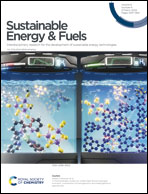A high-entropy layered P2-type cathode with high stability for sodium-ion batteries†
Abstract
Layered transition metal oxides are the most promising cathode materials for sodium-ion batteries, however, the cycling stability and rate performance of this type of cathode materials are very limited. Herein, a solid-state reaction method is developed to synthesize micrometer-sized bulk crystals of the P2-type cathode of Na0.85Li0.12Ni0.198Be0.011Mg0.011Mn0.66O2 (denoted as NLNBMMO-5%) via configurational entropy. The high-entropy layered oxide cathode exhibits superior rate capability, delivers a high reversible capacity of 102.6 mA h g−1 at 1C with a capacity retention of 94.2% after 100 cycles, and maintains a capacity of 78.2 mA h g−1 at 5C with a capacity retention of 78.3% after 300 cycles. This new strategy reduces the ratio of Mn3+/Mn4+, which alleviates the Jahn-Teller distortion effect and enhances the structural stability. Moreover, it expands the interlayer spacing that ensures the excellent rate performance of the cathode, as confirmed by the XPS, the Rietveld refinement of the XRD and the GITT measurement. This work demonstrates that the new composition cathode NLNBMMO-5% is promising for rechargeable sodium-ion batteries with a long cycling life and excellent rate performance.

- This article is part of the themed collection: Most Highly Cited in RSC Energy 2024


 Please wait while we load your content...
Please wait while we load your content...